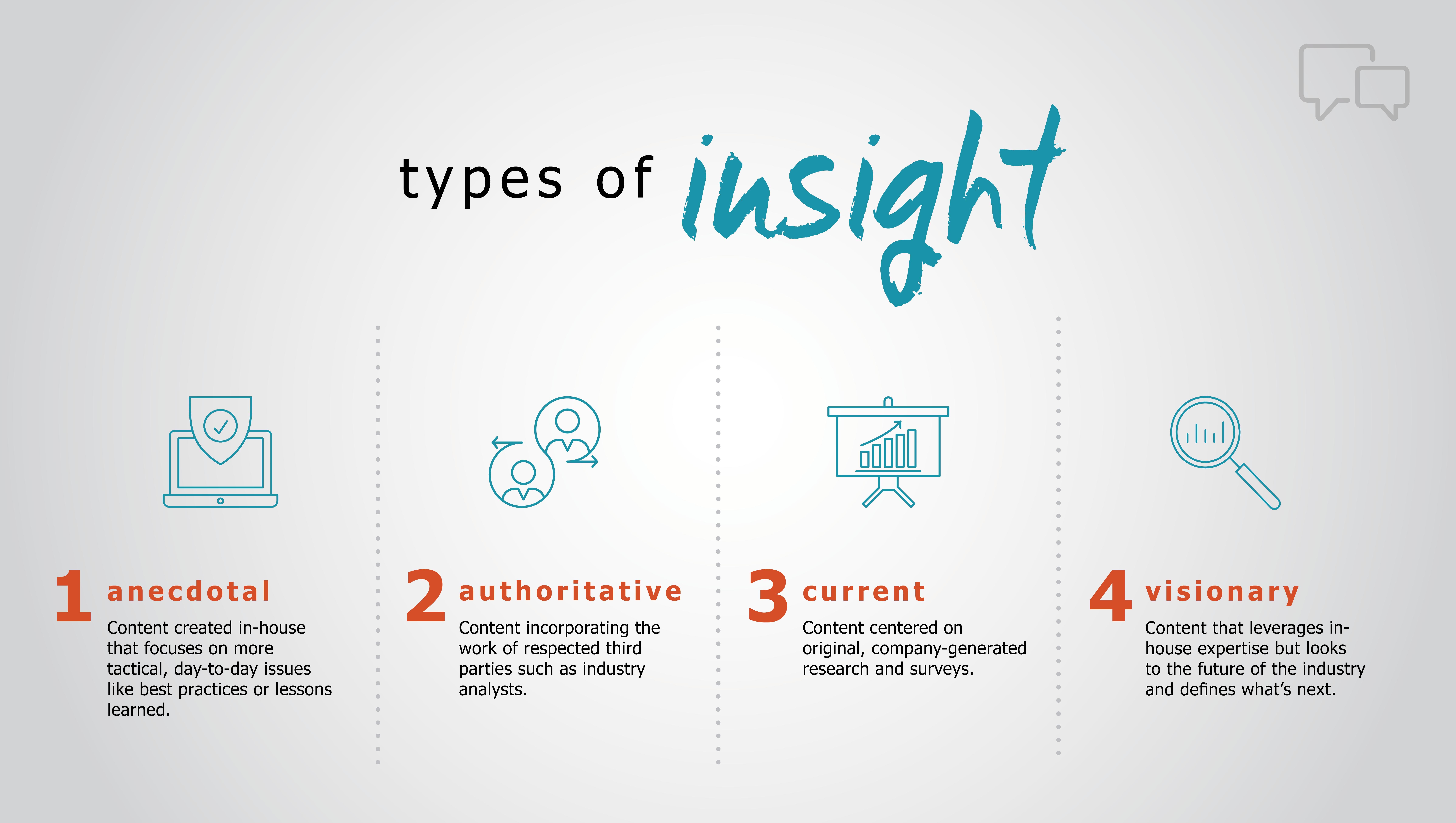
what is insight selling?
Even if you haven’t heard the term “insight sales,” you’re probably familiar with the concept.
Insight selling is sharing relevant and interesting information with a buyer as part of your sales process. This isn’t information about your product but should be something that will give buyers additional context as to why they need your product. Sellers can use compelling insights to position themselves as trusted advisors and demonstrate that they understand their buyer’s needs.
Insight sales examples include sharing things like data about your buyer’s business, trends you’ve noticed in their industry, or current economic or global forces impacting the market.
are sales teams actually doing insight selling?
Insight sales is everywhere—at least, that’s the impression in the market. According to a Corporate Visions survey, 81 percent of companies say they’re selling with insights.
Selling with insights has become so popular over the years that the industry has various standards—some rigorous, others lax—about what qualifies as insight selling today.
But, regardless of how companies internally define what insight sales is, and regardless of the quality of insights their sellers are delivering, you can bet on this:
An insight sales process has been roundly embraced as a key element of provocative selling. In other words, insight sales, rigorously developed or not, has saturated the sales market.
Because insights are so pervasive in the sales industry, the bar for qualifying as a credible insights provider is rising.
Your competitors all have access to the same information as you. So the traditional “insights” selling model of recycling third-party analyst figures, re-packaging those findings, and laying claim to the concepts will only commoditize your sales message.
That approach doesn’t deliver insights. It delivers true but ultimately useless information to your buyers.
Well-thumbed analyst reports and established marketing information won’t have an impact on more discerning prospects and customers, who are demanding more than just regurgitated facts and figures to make purchasing decisions.
As a result of this shift among buyers, sellers need to break this cycle of “true but useless” information and take a more edgy, counterintuitive approach to insight selling, supported by original, research-based rigor.
what should you share when insight selling?
You want to share relevant information with your buyers, but not all insights are created equal.
There are four main types of insights used by salespeople:
- Anecdotal – Content created in-house that focuses on more tactical, day-to-day issues like best practices or lessons learned.
- Authoritative – Content incorporating the work of respected third parties like industry analysts.
- Current – Content centered on original, company-generated research and surveys.
- Visionary – Content that leverages in-house expertise but looks to the future of the industry and defines what’s next.
Some of these insight types are simply better than others at revealing deficiencies or missed opportunities in your prospect’s current situation. And some are better than others at adding urgency and persuading buyers to act now in the sales cycle.
In one survey of the four types of insights, respondents deemed anecdotal insights to be the least effective in terms of achieving positive selling outcomes with buyers. Ironically, respondents said this insight type appeared most often in their campaigns and sales content.
The survey also revealed that “visionary” insights, based on original, company-generated research and forward-looking market interpretations, were viewed as the most effective insight type, but were used the least in sales situations.
So, if you want to stand out from your competition, visionary insights are what you need to share to make the biggest impact.
deliver visionary insights when selling
To be truly visionary, your insight selling messages and content must be:
- Original – Carry out primary research or market surveys to uncover market-related data that will resonate with your buyers. Ensure that they’re statistically relevant and have sound conclusions to increase your effectiveness during a sales call.
- Exclusive – Generate data points that are unique to you and that you can use as the foundation for developing counterintuitive insights about emerging trends in your market. You can then use these insights—which you own—to carve out distinct positioning for your products and business strategy that your buyers will gravitate to.
- Forward-looking – Develop a content-driven narrative on both sides of the lead handoff that asserts a distinct point of view to your buyer—a perspective that shapes the conversation and leverages your findings to deliver unique interpretations of emerging issues, challenges, and trends.
If you can develop a visionary insight that reveals an inconsistency or uncertainty in the way a prospect’s doing something today, the better you’ll truly set yourself apart from other insight sellers.
how should you deliver your insights?
When you create and deliver insights-based messages, you hope the story you tell will promote behavior change in your buyers. In other words, you want your insights to not only pique your buyer’s interest momentarily but actually motivate them to act.
1. use risk + resolution framing
We conducted an experiment to compare the impact of two types of insight-based messages on behaviors and emotions. One message presented only a risk, while the other presented both the risk and a potential resolution.
The results showed that the message with both risk and resolution was significantly more persuasive.
The study suggests that although presenting risks alone can grab a prospect’s interest, it’s not as effective as pairing those risks with specific ways to resolve the issue. By combining risk and resolution in an insights-based message, sellers can elicit the desired emotional response and incite behavior change.
You can apply these findings by offering an insight that highlights the risk associated with your buyer’s current business practices. Introducing a risk they can’t ignore builds urgency in their minds to take action. Then, you can present your product as the solution to resolve those risks.
2. use questions wisely in insight selling
When most sellers think about insight selling, they lean on a popular sales technique known as “diagnose then prescribe.” This selling tactic involves asking prospects a series of questions to identify their problems, and then presenting your solution to address those identified needs.
However, our researchers wanted to determine if this discovery method was the best way to use questions and insights together in the sales process.
One study aimed to investigate whether message effectiveness and persuasion differ based on whether diagnostic questions are asked before or after delivering an insight. Message effectiveness was measured by how influential, compelling, and shareable the message was and, most importantly, how likely the receiver was to buy a new product to solve their problem.
The study found that sharing an insight before asking diagnostic questions to a buyer can enhance the persuasive power of a message.
Questions remain critical in transferring ownership of the insight and initiating the process of self-persuasion, but they only have the desired impact when asked after delivering an insight to the buyer.
You can easily apply these findings by following the Data, Insight, Question (DIQ) framework:
- Data – Begin by sharing relevant data related to an external factor that’s important to your buyer’s business.
- Insight – Next, turn that data into an insightful message by placing the information within the context of your buyer’s current situation.
- Question – Only after presenting an insight should you ask a reflective question to provoke a dialogue.
By using this approach, you give context to your insight, directly related to your buyer’s needs, and then engage them in thinking about what they need to do about the insight you shared.
when should you share your insights in the sales process?
Depending on what type of sales conversation you’re having, it’s important to understand not only what kind of insights to share, but also when to deliver them to have the most impact during the sales process.
For example, there’s a 180 degree difference between what motivates prospects versus your existing customers to buy. And our research shows that timing your insights correctly can make a marked difference in your chances at winning those conversations.
In a customer acquisition conversation, the most influential insights tell your prospects something they don’t already know about an unrealized problem or missed opportunity that’s holding them back from their business goals. This technique is called messaging to a prospect’s “Unconsidered Needs.”
In a customer expansion conversation, any insights you share should introduce “hard truths” about why they need to evolve their situation, but only after you reinforce your value as their established vendor.
By tuning your insights to the motivations of each audience, you maximize relevance and influence at different moments in the Customer Deciding Journey.
how can you tell if your insights are resonating with your buyers?
In our analysis of buyer feedback from more than 100,000 B2B deals, revealed eight key skills that represent critical moments that can win or lose a sale in your buyer’s decision-making process.
Providing expert insights is one of those make-or-break skills. If your buyer doesn’t feel like you’re providing insights that create a compelling vision of the future and give them a convincing reason to change, chances are you aren’t going to win that sale.
The problem is buyers won’t always be able to articulate if inadequate insights caused a lost sale unless you ask them directly. Obtaining buyer feedback from all your sales calls is one of the easiest ways to see whether your insights are hitting the mark and driving decisions.
make insight selling work for your business
Insight selling, when done well, is a powerful technique that can help sellers build credibility and trust with buyers. While many sellers claim to be doing it, few are truly doing it well.
Developing insights that are considered visionary and then delivering them in a way that compels your buyer to act, establishes credibility, and builds trust with your buyers. Ultimately, doing this well will set you apart from your competition and persuade your buyers to choose you.
Learn more science-backed strategies to win your most critical sales conversations.






